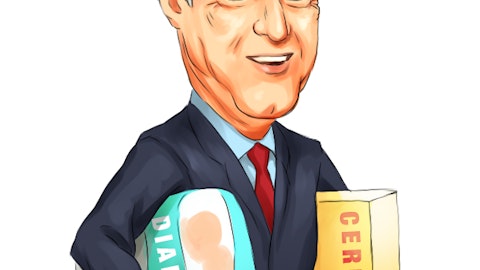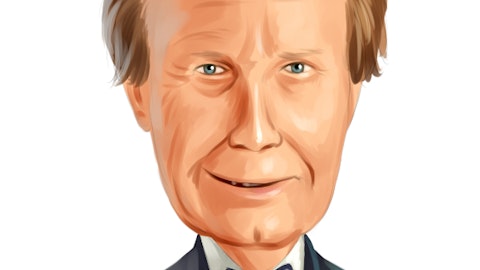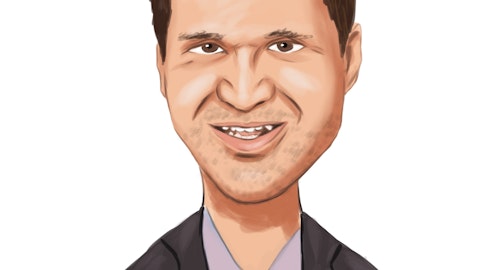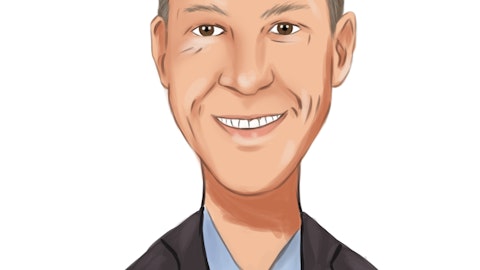L.B. Foster Company (NASDAQ:FSTR) Q4 2022 Earnings Call Transcript March 6, 2023
Operator: Good day and thank you for standing by. Welcome to the Q4 2022 L.B. Foster Earnings Conference Call. At this time, all participants are in a listen-only mode. After the speakers’ presentation, there will be a question-and-answer session. Please be advised that today’s conference is being recorded. I would now like to hand the conference over to your speaker today, Stephanie Listwak. You may now begin.
Stephanie Listwak: Thank you, operator. Good morning, everyone, and welcome to L.B. Foster’s fourth quarter of 2022 earnings call. My name is Stephanie Listwak, the company’s Investor Relations Manager. Our President and CEO, John Kasel; and our Chief Financial Officer, Bill Thalman, will be presenting our fourth quarter operating results, market outlook and business developments this morning. We will start the call with John providing his perspective on the company’s recent portfolio changes and fourth quarter performance, including market development. Bill will then review the company’s fourth quarter financial results. John will provide perspective on the company outlook and his closing comments. We will then open the session up for questions.
Today’s slide presentation, along with our earnings release and financial disclosures, were posted on our website this morning and can be accessed on our Investor Relations page at lbfoster.com. Our comments this morning will follow the slides in the earnings presentation. Some statements we are making are forward-looking and represent our current view of our markets and business today. These forward-looking statements reflect our opinions only as of the date of this presentation, and we undertake no obligation to revise or publicly release the results of any revisions to these statements in light of new information, except as required by securities laws. For more detailed risks, uncertainties and assumptions relating to our forward-looking statements, please see the disclosures in our earnings release and presentation.
We will also discuss non-GAAP financial metrics and encourage you to read our disclosures and reconciliation tables provided within today’s earnings release and within our accompanying earnings presentation carefully as you consider these metrics. Additionally, during the years ended December 31, 2022 and 2021, the company completed three acquisitions and two divestiture transactions in line with its strategic transformation plan. Where meaningful, some of today’s comments adjust for the impact of these strategic portfolio changes to highlight performance from ongoing operation. So, with that, let me turn the call over to John.
John Kasel: Thanks, Stephanie, and hello, everyone. Thanks for joining us today for our fourth quarter earnings call. If you’re following the presentation materials, please turn to Slide #5. As you know, we began a strategic transformation that we fostered in late 2021. And I’m pleased to say that the work in the fourth quarter was another positive step in the transformation of the company. As a summary, since a refresh strategy was rolled out, we completed five transactions, which were comprised of three companies we acquired from our growth platforms, and two legacy noncore companies we divested. These transactions were completed. During the time we faced unprecedented operating challenges, particularly around raw material inflation, supply chain disruptions, and labor availability.
What you’ll hear on today’s call is that we were able to overcome these challenges and deliver strong results in Q4 and in the second half of 2022, continuing to build on the momentum moving into 2023. Specifically, in the fourth quarter, we continued the trend of strong year-over-year improvements and results established in the third quarter with Q4 revenues up 21.4% versus last year. Our portfolio transformation and margin improvement initiatives delivered a strong 260 basis point improvement in gross margins, and a $7.5 million in adjusted EBITDA, which was 5.5% of the net sales and up nearly 133% over last year. Order rates were very robust at $137.8 million, up nearly 45% over the last year, and our backlog remained at near record levels of $272 million.
With the outlook for our key end markets remaining promising and our strategic transformation on track and taking hold, we issued financial guidance for 2023 which reflects a continuation of strong year-over-year growth. And with the prospects for improving financial outlook, our Board of Directors authorized a three-year $15 million stock buyback program. I’ll cover these points in detail towards the end of the presentation. For now, let’s turn it over to Bill to cover the financial highlights of the quarter and full year. Over to you, Bill.
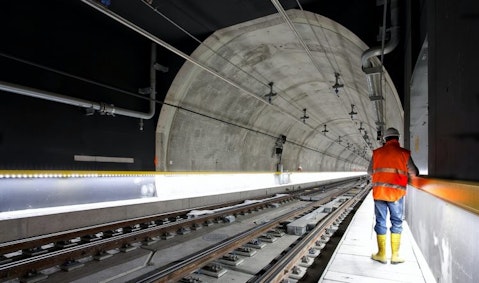
Photo by Ricardo Gomez Angel on Unsplash
William Thalman: Thanks, John. And good morning, everyone. I’ll begin my comments by covering the fourth quarter highlights on Slide 7. Note that the schedules in the appendix provide more detailed information on our financial results, including the non-GAAP measures Stephanie referenced. As a reminder, we divested the Piling business in 2021 and Track Components in 2022 These transactions were not treated as discontinued operations. Accordingly, the amounts presented today include the Piling business within the Steel Products and Measurement segments, with Track Components reflected in Rail, Technologies and Services. Fourth quarter sales were $137.2 million, an increase of $24.2 million over Q4 last year, driven by strong organic growth and the accretive strategic transformation actions taken in 2022.
The improved business portfolio can be seen in our gross margin expansion, which was up 260 basis points, largely due to our acquisition and divestiture activity. Margins in the legacy business also contributed 70 basis points to the improvement. SG&A expense was up $5.2 million due to the additional expenses from acquired businesses, coupled with M&A transaction costs, and increased personnel expenses during the quarter. The reported net loss for the quarter was $43.9 million, and was due to two specific noncash items. $8 million was attributed to intangible asset impairment charges required in two of our returns businesses. $5 million in our precision measurement business and $3 million in fabricated bridge products. Both of these businesses have been experiencing increasingly difficult market conditions.
As a result of our reassessment of their longer term outlooks, these charges were required in the quarter. In addition, we recorded a $37.9 million tax valuation allowance in the quarter, fully reserving our net deferred tax asset position at year-end. This valuation allowance was necessary based on an evaluation of cumulative historical evidence as required by the accounting standards. These standards preclude us from putting much weight on expected future taxable income in our assessment of the net tax asset position, thus resulting in the full valuation allowance. As our strategic transformation continues to drive growth and profitability improvements in the coming years, these tax assets, most of which have an indefinite carry forward period, are expected to provide a valuable tax shield reducing our cash tax obligations for years to come.
Adjusted EBITDA in Q4 increased $4.3 million to $7.5 million, a 132.6% increase year-over-year. I’ll cover the drivers of this improvement on the next slide. Fourth quarter orders totaled $137.8 million up 44.8% over the prior year. Orders improved 32.1% organically and 15.4% from acquisitions, and only slightly offset by a 2.7% decline from divestitures. Fourth quarter backlog increased $62.1 million year-over-year due to a 22.9% organic increase and 7.4% increase from acquisitions, partially offset by a nominal decline from divestitures. I’ll spend a minute on Slide 8 which provides an overview of the drivers of our year-over-year improvement in the fourth quarter. The chart on the left shows the improvement in sales, which reflects the notable $14.6 million organic growth in the legacy business during the quarter, representing a 12.9% increase year-over-year.
The impact driven by portfolio activity added $13.6 million in sales from acquisitions, with a $4 million decline attributable to divestitures. The adjusted EBITDA chart is a powerful depiction of the profitability lift we achieved in both our legacy business as well as from our portfolio moves. Adjusted EBITDA for the current year fourth quarter removes the impact of acquisition and divestiture related costs, the VanHooseCo inventory purchase accounting and contingent consideration expenses, and the fourth quarter intangible impairment charges. Our legacy business delivered a $1.1 million increase in adjusted EBITDA, representing 7.5% leverage on the incremental sales achieved in the quarter. The impact of the portfolio transformation is even more significant with a $3.2 million increase in adjusted EBITDA achieved on the net $9.6 million sales growth from M&A related activities, representing approximately 33% leverage on the net M&A related sales growth.
The combined result is a meaningful increase to our overall profitability with $7.5 million in adjusted EBITDA, representing a 5.5% of net sales and nearly double the EBITDA margin reported in Q4 last year, and up 233% on an absolute dollar basis. Slide 9 highlights that this is the second quarter in a row in which we reported a significant improvement in our run rate profitability. During 2021 and in the first half of 2022, we were faced with unprecedented inflationary, labor and supply chain challenges in addition to underperforming businesses within our portfolio. The chart reflects the adjusted EBITDA margins in the first and second half of 2021 and first half of 2022, and highlights the deterioration we were seeing in our results. This situation became the burning platform for change as outlined in our refreshed enterprise strategy.
We began to see the benefits from our margin recovery actions and portfolio transformation in the 2022 third quarter results. And this trend continued into the fourth quarter. The combined result is a 6.2% adjusted EBITDA margin for the 6 months ended December 31, 2022, a step change improvement over the previous three 6 month periods. These results give us confidence that our strategic transformation is on track and taking hold. Over the next three slides I’ll cover the performance of each segment starting with our Rail segment on Slide 10. Fourth quarter Rail segment revenue increased $6.9 million year-over-year driven by a 10.2% organic growth, partially offset by a nominal reduction associated with acquisition and divestiture activity. Gross margins expanded by 350 basis points, due to an improved margin profile with the acquisition of Skratch, and the divestiture of Track Components, coupled with volume leverage in Rail Products.
New orders in Q4 were up nearly 26% year-over-year and backlog was up 9% versus last year, with broad strength in demand across the portfolio Turning to Precast Concrete on Slide 11, revenue increased $16.5 million, representing an 81.3% improvement year-over-year. Organic sales increased 24.8% and the VanHooseCo acquisition contributed 56.5% in growth year-over-year. Gross margins increased 220 basis points driven by the impact of the VanHooseCo acquisition and the reported segment margins included a $300,000 unfavorable inventory purchase accounting adjustment, which diluted segment margins by 80 basis points. Orders and backlogs levels are up year-over-year both from the VanHooseCo acquisition and strong demand environment for products in our legacy business.
And we expect this favorable trend to continue with the announced government infrastructure funding programs. For the Steel Products and Measurement segment on Slide 12, revenues increased $800,000 or 3.6% year-over-year. The organic sales increase was 11% offset by a 7.4% decrease from the sale of the Piling business. Gross profit margins improved by 30 basis points with the increase attributable to the sale of the Piling business and margin improvements in Coatings and Measurement, partially offset by weaker margins realized in our Fabricated Bridge business. Order rates in Q4 increased 95.2%, while backlog increased 92.3%, driven by the Coatings and Measurement business unit, with approximately half of the backlog increase attributable to the Summit pipeline coating order booked in the third quarter of 2022.
I’ll now cover our 2022 full year results reflected on Slide 13. 2022 sales decreased $16.1 million or 3.1%. The impact of divestitures drove 12.8% of the decline, partially offset by a 5.7% increase from organic sales and 4% from acquisitions. Despite the sales decline, gross profit for 2022 finished at $89.6 million, up $3.3 million or 3.8% versus last year. The increase in reported gross profit was driven by the accretive impact of the portfolio changes executed as well as improvement in our legacy business, as pricing and cost mitigation actions began to take hold in the second half of the year. The increase in gross margins for the full year was realized despite the $4 million unfavorable settlement related to longer term Crossrail projects, as well as a $1.1 million adjustment for the VanHooseCo inventory purchase accounting adjustment.
In total, both adjustments diluted 2022 reported margins by 100 basis points. Selling and administrative expenses for 2022 increased $6.7 million or 8.8%, representing 16.6% of sales for the full year, up from 14.8% in 2021. The increase relative to sales was largely due to the expected impact of portfolio transformation activities, including $2 million in acquisition costs and $0.5 million in VanHooseCo contingent consideration in addition to increases in personnel, travel and professional services costs. Backlog remains near record levels with a full year book-to-bill ratio of 1.11. A discussion of our liquidity and priority uses of cash is reflected on Slide 14. I’ll start by highlighting that our gross leverage ratio per our credit agreement covenant declined a half a turn in Q4 to 2.8x, well below the 4.0x requirement.
We chose to highlight the gross leverage credit agreement covenant as we believe it’s representative of our true credit leverage given the portfolio moves we’ve made. Free cash flow generated in the quarter reduced our net debt by $5 million to $89 million at year-end. Highlighting the meaningful portfolio moves we’ve accomplished, we’ve redeployed nearly $32 million in unproductive capital to three investments within our growth platforms: Skratch and IV within Rail Technologies, and VanHooseCo in Precast Concrete. Our attention now turns to further investing in organic growth initiatives within these platforms. You’ll note that CapEx is projected to be approximately 2% of sales which is slightly higher than our historical range of 1% to 1.5% of sales.
The incremental investment is specifically tied to growth opportunities clearly insight, and we expect the payback on these investments to be approximately two years. We will modestly allocate more capital to fund organic growth opportunities in Precast Concrete and Rail Technologies but our top priority use of cash is to continue to delever. We’ve made further progress reducing our net debt in early 2023 with the February month end balance at approximately $80 million, down $9 million from the start of the quarter. We’re pleased to report that we’ve collected an additional $3 million Federal income tax refund in February, and we have additional deleveraging projects underway. I’ll remind everyone that we have approximately $96 million in Federal net operating loss carry forwards available to minimize U.S. cash taxes in the future.
I’ll highlight that the deferred tax valuation allowance recorded in Q4 does not impact the availability of these tax credits. And lastly, our settlement obligation with Union Pacific stands at $16 million and will be fulfilled in December of 2024, resulting in an $8 million per year boost in operating cash flow beginning in 2025. The expected improved cash flow and leverage outlook was a critical driver of the decision to authorize the $15 million stock buyback program which John will cover in his closing remarks. In summary, we will continue to maintain a prudent, cautious capital allocation philosophy as we execute our strategic transformation. My closing comments refer to Slides 15 and 16 covering orders, revenue and backlog by segment.
The book-to-bill ratios on Slide 15 reflect the increasing strength we’ve seen in our business through the fourth quarter. Rail orders were up 25.9% year-over-year and up approximately 30% sequentially driving the robust sales performance in the Rail segment in Q4. The favorable 1.05 book-to-bill ratio for the full year translated to a 9% increase in the Rail backlog. The Precast Concrete backlog also increased during 2022 with a favorable book-to-bill ratio at 1.04 and the addition of VanHooseCo translating to increasing orders and sales each quarter throughout 2022. And the Steel Products and Measurement order rates for the year substantially outpaced revenues largely due to the Summit order booked in Q3. Their performance was a major contributor to the consolidated book-to-bill ratio of 1.11 for the full year.
And lastly, our consolidated backlog on Slide 16 reflects robustness across the portfolio with year-over-year growth generated in all segments. Our year-end backlog remains near record levels achieved in the third quarter and is up approximately 29.5% versus this time last year. The backlog was impacted by a 22.9% organic increase, with the remaining 6.6% net increase due to portfolio moves. The strong order intake and backlog levels demonstrate the ongoing strength in the business and commercial markets we serve. While recessionary market conditions remain a broader macro risk, we remain optimistic in both the near and longer-term prospects for growth in our served markets, and the support the announced government funding programs are expected to provide.
Thank you for your time. I’ll now hand it back over to John for his closing remarks. John?
John Kasel: Thanks, Bill. Please turn to Slide 18. I’ll start my closing remarks on the overall marketing and business outlook. The portfolio moves we have made demonstrate our commitment to executing the strategy, investing in our growth platforms. As Bill mentioned, our backlog is near record high levels and we remain optimistic in the longer-term outlook for our core end markets, namely in the rail and general infrastructure space. We continue to focus on ensuring a seamless integration of the businesses we acquired this past year, while assessing the new market opportunities these acquisitions open up. I’m pleased to say that the 2022 acquisitions have met our expectations and are accretive to the operating margins of the company.
Building on these new acquisitions and moving into 2023, our attention will return to driving organic programs in both current and adjacent markets, made available through our strategic execution. We continue to have portfolio challenges to address, particularly in the Steel Products and Measurement segment. As Bill mentioned, non-cash asset impairment charges were taken in the Fabricated Bridge and Precision Measurement businesses, both of which faced weaker market demand and inflationary headwinds. As a note, we are focusing on stabilizing and establishing recovery programs for these return businesses in the short-term. On the favorable side, we continue to see improving outlook for our Coatings business with Q4 order rates up 30% year-over-year and some of the order booked in Q3 of last year is expected to begin delivery in 2023.
And while recessionary risk persist in many of our industrial markets, we remain cautiously optimistic that the previously announced government infrastructure programs will provide some level of support for demand of our products and services. We continue to have line of sight to significant infrastructure projects across the portfolio that are well aligned to our growth strategy and quotation activity remains robust. So we remain focused on our order book execution and driving profitability improvement programs, while ensuring our supply chains are stable and secure. Turning to Slide 19 and as I mentioned in my opening comments, we established the sales and EBITDA guidance for 2023. This is the first time we’ve provided full year guidance since 2016, highlighting our belief that our strategic transformation is on track and business prospects are improving.
We expect 2023 sales to range between $540 million and $570 million, with a range representing year-over-year growth of 8.5% and 14.6% respectively. This outlook assumes no portfolio actions, I will note. Adjusted EBITDA in 2023 is expected range between $27 million and $31 million with corresponding percent of sales range between 4.7% and 5.7%. The expected adjusted EBITDA margin range is lower than we’ve seen of 6.2% in the second half of 2022, but this is due to normal seasonality in the business. As a note, we will provide periodic updates to our guidance as the year progresses. And lastly, our Board of Directors has approved a $15 million company stock buyback program, representing approximately 11% of our market cap. The three-year program expires in February of 2026, and limits purchases to no more than $5 million during any trailing 12-month period.
The program provides an important additional lever to allocate capital strategically as cash flows and liquidity improve in the future. In closing, 2022 was a significant transition year for us, during which we created strong momentum in results. As demonstrated in our actions and our results, we are transforming L.B. Foster into technology-focused, high-growth infrastructure solutions provider. The favorable impact of our strategic transformation was evident in the results we posted in the second half of 2022. It’s been 15 months since we rolled out our refresh strategy, execution roadmap and aspirational goals of $600 million in revenue, and $50 million in EBITDA as you can see on slide 20. But I’m very proud of what our employees have accomplished in such a short period of time, but also recognize these are still the early days in our transformation journey.
We plan on continuing to leverage and expand the growth platforms we established in Rail Technologies and Precast Concrete, and expect to deliver continued growth as we transition is 2023. At the same time, we intend to continue to drive our returns portfolio to provide cash needed to prudently invest and manage our overall capital structure. I look forward to reporting on our continued progress in ’23 and thank all of our stakeholders for their ongoing support. I’d like to end the call with a comment on safety. Safety is at the forefront of the rail industry we serve today. And our thoughts are with the people of East Palestine, Ohio, a community that’s only 50 miles from where I’m speaking to you today. Safety is also a core value of the L.B. Foster Company and I’d like to recognize Brian Friedman, who leads our Steel Products and Measurement segment.
After many years with substandard performance, Brian and his team went the entire year of 2022 with no recordable injuries. This is a leadership that we aspire to at L.B. Foster and underpins the value that strengthens the company’s culture to ensure this strategic transformation, actions that we spoke up today, have a strong base to grow from in the future. Great job to you, Brian, and your team. Operator, will now turn it back to you for the Q&A session.
See also Bill Gates’ Current Portfolio: 10 Dividend Stocks and 10 Best March Dividend Stocks to Buy .
Q&A Session
Follow Foster L B Co (NASDAQ:FSTR)
Follow Foster L B Co (NASDAQ:FSTR)
Operator: And our first question will come from Alex Rygiel of B. Riley Securities.
Alex Rygiel: A couple of quick questions here. What do you think a good intermediate term target is for organic growth of the business right now?
John Kasel: Yes. You’re talking about in sales primarily?
Alex Rygiel: Yes. Yes, I’d say total company sales organic growth target and kind of intermediate term meaning kind of next one to two years.
John Kasel: Yes, I’d say, well, first of all, we’re going to be focusing on the Rail Technologies and Precast is where the organic capital will be spent for organic programs. So that’d be real clear line of sight where we expect to invest as well as get those returns. I think, Bill, you think we can add a little color. What we’ve?
William Thalman: Yes. Yes, I would say, the guidance that we provided for 2023 has a range of 9%, 8.5%, up to 14.6%. Obviously, there’s a little bit of carryover effect of the acquisitions that we’ve done in 2022 that will manifest itself in those growth rates into 2023. And then, I think organically we’re looking at high single-digits would be where we’re focused. I will highlight, we mentioned in the script that we’ve got some organic growth programs identified within the rail technology space and the precast space, both related to the acquisitions that we’ve done. So the CapEx will be a little heavier than what we’ve seen in the past. But we like what we see in terms of organic growth programs. And we feel like we have a good opportunity to leverage those platforms, given the work we’ve done.
Alex Rygiel: And then from a high-level over that sort of one to two-year time period, can you sort of list the largest contributors to EBITDA margin improvement?
John Kasel: Well again you should go back to our aspirational goals which I finished the presentation with or at least in my closing comments, so we still — aspirational would be $600 million by 2025. So let’s pick that number. $50 million of EBITDA. This year was a big year for us 2022 Alex. So some of the portfolio moves we made, the two divestitures, as well as the three acquisitions has really put us in a position where we can have a clear line of sight to hit those aspirational goals. So a good part of what we’re going to be seeing here in the next few years as far as growth in top and bottom line, as well as leveraging our SG&A, will come from the rail specific technology side, on the digital side, the information side as well as in the precast side. So we feel very good about our ability to make that happen, with or without the infrastructure spending that we’re seeing today. We’ve feel pretty good about where we’re at and more importantly, where we’re heading.
Operator: Our next question comes from Chris Sakai of Singular Research.
Chris Sakai: Just a question on — are you seeing an uptick in new orders in rail after the Ohio train derailment and all that going on?
John Kasel: We don’t comment on anything related to that ongoing investigation. But I do want to make sure everybody understands that we have complete confidence in the NTSB as well as a higher level of respect for NS as a customer. Having said that, our activity — and I mentioned in my remarks, the bidding activity right now in the rail space as well as across the company is very robust right now. So we don’t necessarily point to anything related to what specific incident. Activity itself in general is very, very strong right now.
Chris Sakai: Okay. Thanks for that. And then your increase in guidance for 2023, how much of that would you say is related to the Infrastructure Bill?
